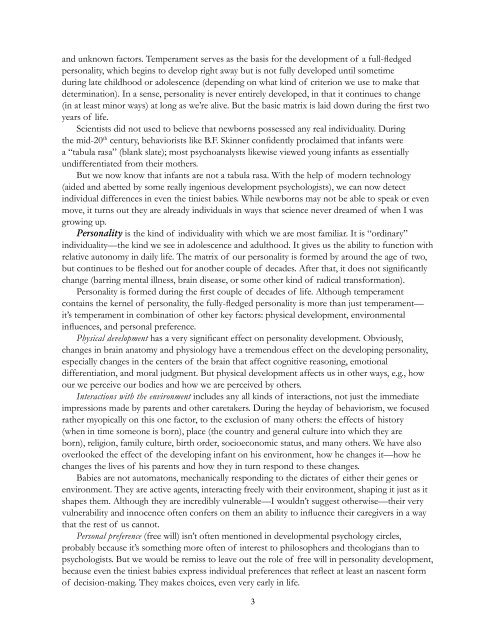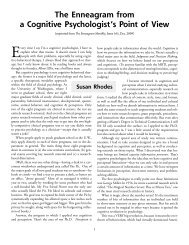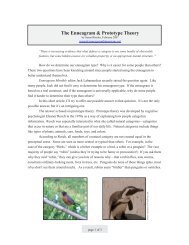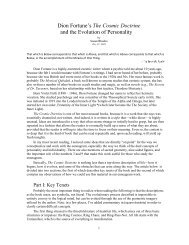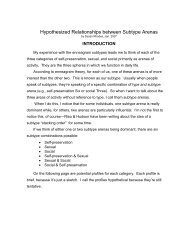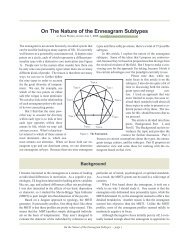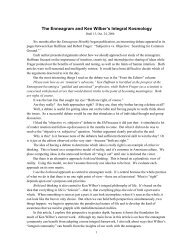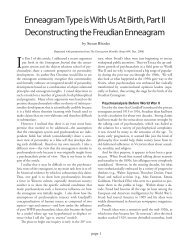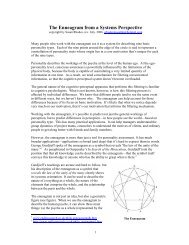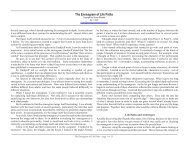The Enneagram of Individuality - Enneagram Dimensions
The Enneagram of Individuality - Enneagram Dimensions
The Enneagram of Individuality - Enneagram Dimensions
Create successful ePaper yourself
Turn your PDF publications into a flip-book with our unique Google optimized e-Paper software.
and unknown factors. Temperament serves as the basis for the development <strong>of</strong> a full-fledged<br />
personality, which begins to develop right away but is not fully developed until sometime<br />
during late childhood or adolescence (depending on what kind <strong>of</strong> criterion we use to make that<br />
determination). In a sense, personality is never entirely developed, in that it continues to change<br />
(in at least minor ways) at long as we’re alive. But the basic matrix is laid down during the first two<br />
years <strong>of</strong> life.<br />
Scientists did not used to believe that newborns possessed any real individuality. During<br />
the mid-20 th century, behaviorists like B.F. Skinner confidently proclaimed that infants were<br />
a “tabula rasa” (blank slate); most psychoanalysts likewise viewed young infants as essentially<br />
undifferentiated from their mothers.<br />
But we now know that infants are not a tabula rasa. With the help <strong>of</strong> modern technology<br />
(aided and abetted by some really ingenious development psychologists), we can now detect<br />
individual differences in even the tiniest babies. While newborns may not be able to speak or even<br />
move, it turns out they are already individuals in ways that science never dreamed <strong>of</strong> when I was<br />
growing up.<br />
Personality is the kind <strong>of</strong> individuality with which we are most familiar. It is “ordinary”<br />
individuality—the kind we see in adolescence and adulthood. It gives us the ability to function with<br />
relative autonomy in daily life. <strong>The</strong> matrix <strong>of</strong> our personality is formed by around the age <strong>of</strong> two,<br />
but continues to be fleshed out for another couple <strong>of</strong> decades. After that, it does not significantly<br />
change (barring mental illness, brain disease, or some other kind <strong>of</strong> radical transformation).<br />
Personality is formed during the first couple <strong>of</strong> decades <strong>of</strong> life. Although temperament<br />
contains the kernel <strong>of</strong> personality, the fully-fledged personality is more than just temperament—<br />
it’s temperament in combination <strong>of</strong> other key factors: physical development, environmental<br />
influences, and personal preference.<br />
Physical development has a very significant effect on personality development. Obviously,<br />
changes in brain anatomy and physiology have a tremendous effect on the developing personality,<br />
especially changes in the centers <strong>of</strong> the brain that affect cognitive reasoning, emotional<br />
differentiation, and moral judgment. But physical development affects us in other ways, e.g., how<br />
our we perceive our bodies and how we are perceived by others.<br />
Interactions with the environment includes any all kinds <strong>of</strong> interactions, not just the immediate<br />
impressions made by parents and other caretakers. During the heyday <strong>of</strong> behaviorism, we focused<br />
rather myopically on this one factor, to the exclusion <strong>of</strong> many others: the effects <strong>of</strong> history<br />
(when in time someone is born), place (the country and general culture into which they are<br />
born), religion, family culture, birth order, socioeconomic status, and many others. We have also<br />
overlooked the effect <strong>of</strong> the developing infant on his environment, how he changes it—how he<br />
changes the lives <strong>of</strong> his parents and how they in turn respond to these changes.<br />
Babies are not automatons, mechanically responding to the dictates <strong>of</strong> either their genes or<br />
environment. <strong>The</strong>y are active agents, interacting freely with their environment, shaping it just as it<br />
shapes them. Although they are incredibly vulnerable—I wouldn’t suggest otherwise—their very<br />
vulnerability and innocence <strong>of</strong>ten confers on them an ability to influence their caregivers in a way<br />
that the rest <strong>of</strong> us cannot.<br />
Personal preference (free will) isn’t <strong>of</strong>ten mentioned in developmental psychology circles,<br />
probably because it’s something more <strong>of</strong>ten <strong>of</strong> interest to philosophers and theologians than to<br />
psychologists. But we would be remiss to leave out the role <strong>of</strong> free will in personality development,<br />
because even the tiniest babies express individual preferences that reflect at least an nascent form<br />
<strong>of</strong> decision-making. <strong>The</strong>y makes choices, even very early in life.<br />
3


